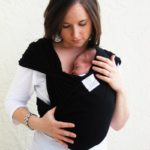Infant Care
Safe Soft Baby Carriers and Slings
To help keep infants and babies safe, the U.S. Consumer Product Safety Commission (CPSC) has approved a new federal mandatory standard intended to improve the safety of infant sling carriers and prevent deaths and injuries to young children.
Infant sling carriers are worn by the parent or caregiver and are designed to carry an infant/toddler in an upright or reclined position. Slings generally are intended for infants and toddlers between 8 and 35 pounds. Designs typically range from unstructured hammock-shaped products that suspend from the caregiver’s body, to long lengths of material or fabric that wrap around the caregiver’s body.
The new federal safety standard incorporates the most recent voluntary standard developed by ASTM International (ASTM F2907-15), Standard Consumer Safety Specification for Sling Carriers, with one modification regarding label attachments. CPSC’s rule modifies the ASTM standard to make warning labels more permanent by preventing the labels from being attached to the sling carrier along only one side of the label.
The mandatory standard contains several requirements for sling carriers including:
loading to ensure that the sling can carry up to three times the manufacturer’s maximum recommended weight,
structural integrity to ensure that after all testing, there are no seam separations, fabric tears, breakage, etc., and
occupant retention to prevent the child being carried from falling out of the sling during normal use.
In addition, the standard requires sling carriers to come with warning labels and instructional literature. These requirements include:
- pictures to show the proper position of a child in the sling
- a warning statement about the suffocation hazard posed by slings and prevention measures
- warning statements about children falling out of slings
- a reminder for caregivers to check the buckles, snaps, rings and other hardware to make sure no parts are broken.
Between January 2003 and September 2016, 159 incidents were reported to CPSC involving sling carriers; 17 were fatal and 142 were nonfatal. Of the 142 nonfatal incidents, 67 reports involved an injury to the infant during use of the product. Among the 67 reported nonfatal injuries, 10 involved hospitalizations.
The effective date for the new mandatory infant sling carrier standard is one year after the final rule is published in the Federal Register. CPSC advises parents and caregivers to be cautious when using infant slings for babies younger than four months of age. Slings can pose two different types of suffocation hazards to babies.
- In the first few months of life, babies cannot control their heads because of still developing neck muscles. The sling’s fabric can hold the baby in a position that blocks the baby’s breathing and rapidly suffocates a baby within a minute or two.
- Additionally, where a sling keeps the infant in a curled position bending the chin toward the chest, the airways can be restricted, limiting the oxygen supply. The baby will not be able to cry for help and can slowly suffocate.
CPSC recommends the following tips to parents and caregivers when using infant sling carriers.
- Make sure the infant’s face is not covered and is visible at all times to the sling’s wearer.
- If nursing the baby in a sling, change the baby’s position after feeding so the baby’s head is facing up and is clear of the sling and the mother’s body.
- Be vigilant about frequently checking their baby in a sling, always making sure nothing is blocking baby’s nose and mouth and baby’s chin is away from her chest.
The U.S. Consumer Product Safety Commission is charged with protecting the public from unreasonable risks of injury or death associated with the use of thousands of types of consumer products under the agency’s jurisdiction. Deaths, injuries, and property damage from consumer product incidents cost the nation more than $1 trillion annually. CPSC is committed to protecting consumers and families from products that pose a fire, electrical, chemical or mechanical hazard. CPSC’s work to help ensure the safety of consumer products – such as toys, cribs, power tools, cigarette lighters and household chemicals -– contributed to a decline in the rate of deaths and injuries associated with consumer products over the past 40 years.
Federal law bars any person from selling products subject to a publicly-announced voluntary recall by a manufacturer or a mandatory recall ordered by the Commission.
To report a dangerous product or a product-related injury go online to www.SaferProducts.gov or call CPSC’s Hotline at 800-638-2772 or teletypewriter at 301-595-7054 for the hearing impaired. Consumers can obtain news release and recall information at www.cpsc.gov, on Twitter @USCPSC or by subscribing to CPSC’s free e-mail newsletters.


